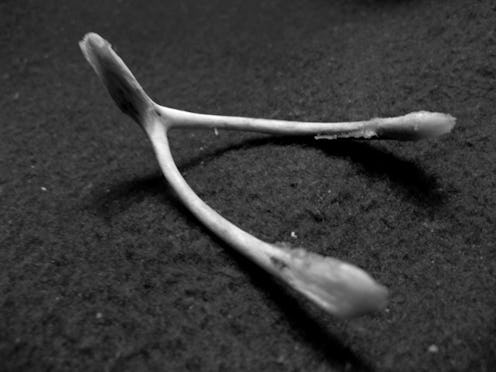Life
6 Surprising Facts About The Thanksgiving Wishbone

So, you're going to face off with a friend or family member for the bigger half of the wishbone on Thanksgiving Day — but, um, why? Seriously, what's the history of the Thanksgiving wishbone, and why has it become such a huge holiday staple? It's important to know the turkey wishbone facts behind this tradition, because this is not a battle to be entered into lightly. It might be Thanksgiving, when everyone is buzzing with the love and gratitude of the holiday season (or maybe it's just a booze-fueled buzz), but you've got a wish you'd like granted, and winning is priority numero uno. Besides, selflessness can wait until after Black Friday, am I right?
In order to make sure you come out victorious with the larger part of the wishbone, you need to understand where it all began. ("WE HAVE TO GO BACK," I said in my best Jack Shepherd voice.) The breaking of the wishbone is a classic and beloved Turkey Day tradition, so you gotta do it justice. And you need to know how to play this game the right way. So when dinner comes to an end, and you get ready to yank that former clavicle and break it in two, you'll be fully prepared to be crowned as champ. Here are six facts you need to know about the wishbone, because knowledge is power, and power will lead you to victory.
1. The Wishbone Is Actually Called The "Furcula"
It's the part of the bone that's formed by the fusion of the clavicles. It's Latin for "little fork." For birds, the furcula is key to being able to fly, because of the tendons that attach to it, and its elasticity. Many dinosaurs had them too!
2. Breaking The Wishbone Is Not An American Thing
Americans didn't start this one, despite the fact that Thanksgiving is an American holiday. Breaking the wishbone for good luck or a wish granted is a tradition that's thousands of years old. Credit should be given to the ancient Romans for this fun, mildly disturbing little game, which was played a little differently back then...
3. It All Started With Chickens, Not Turkeys
Ancient Romans broke chicken wishbones, not those of turkeys. This is because the ancient Romans believed chicken bones were good luck. A rabbit's foot, lentils, white socks, and chicken bones — I mean, why can't humans pick normal good luck charms?
4. English Settlers Brought The Tradition With Them To America
The English just so happened to pick up the good luck tradition of breaking wishbones from the Romans, and brought it with them to Plymouth Rock. And, well, we all know about the importance Plymouth Rock plays in Thanksgiving history.
5. Prime Wishbones Require Patience
The key to having the perfect wishbone to break is giving it enough time to dry out. Some people let it air dry from Thanksgiving to Christmas. Some speed up the process by briefly sticking it in the oven, and some give it a full year. It might seem like a lot of work, but it's definitely worth the effort. That's because if you don't give it enough time to dry, the wishbone will bend and not snap, leaving you with a wishless exercise in arm strength. And nobody wants to work out without a reward, so give it time.
6. There's A Strategy To Winning The Game
Modern Farmer offers some stellar tips on winning the wishbone game. First, use your dominant hand to yank the bone (make sure that hand is completely dry), and use proper placement of your thumb and forefinger. It's not as simple as hold and pull, and in order to make your wish come true, you need to do it right. For a little extra leverage, try grabbing the wishbone closer to the center.
For more Thanksgiving ideas, check out Bustle on YouTube.
Image: Clyde Robinson/Flickr; Giphy (2)